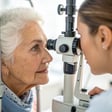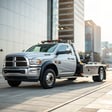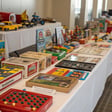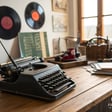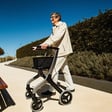Falls among older adults represent one of the most common household dangers. Each year, countless seniors experience injuries that could be prevented.
Understanding Elderly Fall Safety Risks
The statistics paint a concerning picture. According to the National Council on Aging, falls are the leading cause of fatal and non-fatal injuries for older Americans. One in four Americans aged 65+ falls each year, and every 11 seconds, an older adult is treated in the emergency room for a fall-related injury.
Many factors contribute to this risk, including:
- Declining balance and strength
- Vision changes
- Medication side effects
- Chronic health conditions
- Environmental hazards in the home
"Most people don't realize that falls are largely preventable," notes Dr. Elizabeth Harper, a geriatric specialist. "Simple modifications and devices can dramatically reduce fall risks while supporting independence."
Essential Anti-Slip Devices for Everyday Safety
Among the most effective and affordable fall prevention solutions are anti-slip devices designed for various areas of the home.
Bathroom Safety Solutions
The bathroom presents particular dangers due to wet, slippery surfaces. Consider these essential additions:
- Non-slip bath mats with strong suction cups
- Grab bars installed near toilets and in shower areas
- Shower chairs for seated bathing
- Raised toilet seats to reduce strain when sitting and standing
Kitchen and Living Area Protection
Daily activities in these high-traffic areas can be made safer with:
- Non-slip rug pads under all area rugs
- Anti-slip floor treatments that increase traction without changing appearance
- Furniture corner guards to prevent injuries during minor stumbles
- Cable management systems to eliminate cord tripping hazards
One senior homeowner, Margaret, 78, shared: "I was skeptical about making changes to my home at first, but after installing grab bars and non-slip mats, I feel so much more confident moving around."
Advanced Fall Alarms for Seniors
For more comprehensive protection, fall alarm systems provide both prevention and emergency response capabilities.
Wearable Alert Systems
Modern wearable devices have evolved far beyond the "I've fallen and can't get up" pendants of the past:
- Smartwatches with fall detection that automatically alert emergency contacts
- Hip-protecting belts that deploy airbags during falls
- Activity monitoring pendants that track movement patterns to predict fall risk
Home Safety Sensors
Smart home technology now offers sophisticated monitoring without being intrusive:
- Motion sensors that detect unusual movement patterns
- Pressure-sensitive floor mats that alert caregivers when a person gets out of bed
- AI-powered camera systems that respect privacy while detecting emergency situations
The California Department of Aging highlights that many seniors qualify for assistance programs that can help cover the costs of these safety devices. Their website lists various programs and services available to older adults and their caregivers throughout the state.
How Can I Choose the Right Balance Aids for Seniors?
Selecting appropriate balance aids depends on individual needs and home layout. Consider these factors:
- Mobility level - Is the senior using a cane, walker, or wheelchair occasionally or consistently?
- Home environment - Are there stairs, narrow hallways, or other challenging features?
- Personal preferences - Some devices are more discreet than others
- Budget considerations - Many insurance plans, including Medicare, may cover certain devices
Popular balance aids include:
- Multi-point canes for enhanced stability
- Walker/rollator hybrids that adjust to different needs
- Stair lifts for multi-level homes
- Transfer poles that assist with standing from seated positions
"The best approach is often layered," explains occupational therapist James Wilson. "Combining physical aids with environmental modifications creates the safest possible setting."
Innovative Mobility Support Devices
Technology continues to advance the field of mobility assistance with increasingly sophisticated options:
Smart Walking Aids
- Laser-guided canes that project walking paths
- Obstacle-detecting walkers that vibrate when approaching hazards
- Self-balancing walkers that adjust to uneven surfaces
Adaptive Furniture
- Power lift recliners that gently assist with standing
- Adjustable-height beds that make transfers safer
- Swivel seat cushions that reduce twisting strain
Safety Tech for Seniors: The Digital Revolution
The integration of digital technology with traditional safety devices has created powerful new tools to prevent falls elderly residents experience:
- Voice-activated lighting systems eliminate fumbling for switches in the dark
- Medication management systems with reminders reduce confusion that can lead to falls
- Virtual physical therapy programs strengthen balance from home
- GPS tracking devices provide peace of mind for both seniors and caregivers
The National Institute on Aging recommends starting with a home safety assessment, which can often be arranged through local Area Agencies on Aging or healthcare providers.
Creating a Comprehensive Plan to Prevent Falls Elderly Loved Ones Experience
The most effective approach combines multiple strategies:
- Home modification - Install necessary safety devices
- Regular health checkups - Monitor vision, medication effects, and overall health
- Strength and balance exercises - Programs like Tai Chi have proven fall-prevention benefits
- Proper footwear - Non-slip, supportive shoes reduce fall risks
- Lighting improvements - Ensure all areas are well-lit, especially stairways and nighttime pathways
"We've seen a 30% reduction in falls among our clients who implement comprehensive prevention plans," notes Sarah Jenkins of Senior Safe Homes, a home modification service.
Conclusion
Investing in fall prevention devices isn't just about safety—it's about preserving independence and quality of life for seniors aging in place. From simple anti-slip mats to sophisticated monitoring systems, today's options make it possible to create truly safe environments without sacrificing comfort or dignity.
By combining the right devices with proper home modifications and health maintenance, families can significantly reduce fall risks while supporting their loved ones' desire to remain in their own homes.
Disclaimer: This information is provided for educational purposes only and should not be considered medical advice. Consult with healthcare providers and safety experts to develop a personalized fall prevention plan.
Tags

About Elena Schwarzkopf the Author
Elena Schwarzkopf is a seasoned finance writer with over a decade of experience in crafting actionable budgeting tips that help individuals regain control over their finances. Known for her practical approach, Elena's insights empower readers to transform their financial habits and achieve their savings goals.
Recommended Articles
How to Detect Macular Degeneration Early
Learn to detect macular degeneration early through eye exams and understanding symptoms, ensuring proactive eye health management.
Rent-to-Own Tow Trucks: What to Know in 2026
Explore rent-to-own tow trucks in 2026, offering flexibility for operators to gradually gain ownership while managing costs effectively.
How to Spot a Valuable Toy Before Selling It at a Garage Sale
Learn how to identify valuable toys to sell at garage sales, maximizing profit while decluttering your home. Find out what buyers are looking for!
5 Old Household Items That Are Suddenly Worth Money
Discover five old household items that could be worth a lot of money today, from vintage typewriters to collectible toys and more.
The Smart Rollator That’s Redefining Independence for Seniors
Smart rollators are revolutionizing senior mobility by integrating advanced technology, such as intelligent braking systems, GPS for location tracking, and health monitoring features, which improve safety and reduce healthcare costs through fall prevention. These devices, despite their higher upfront cost, offer long-term financial benefits by delaying the need for costly home care, and some insurance plans may cover the associated expenses.
